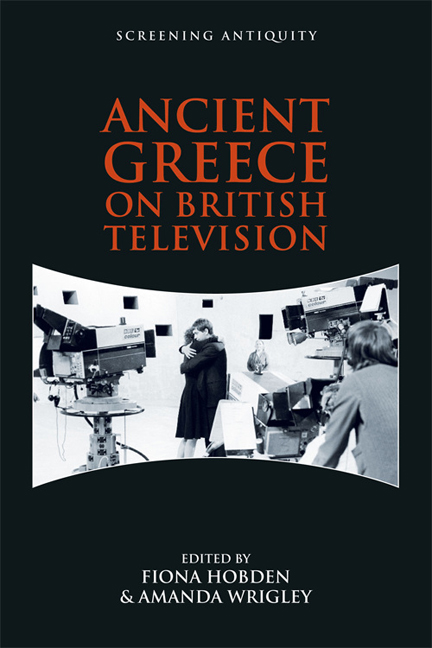Book contents
- Frontmatter
- Contents
- List of Figures and Tables
- Series Editors’ Preface
- Acknowledgements
- Contributors
- Abbreviations
- Broadcasting Greece: An Introduction to Greek Antiquity on the Small Screen
- 1 Are We the Greeks? Understanding Antiquity and Ourselves in Television Documentaries
- 2 Louis MacNeice and ‘The Paragons of Hellas’: Ancient Greece as Radio Propaganda
- 3 The Beginnings of Civilisation: Television Travels to Greece with Mortimer Wheeler and Compton Mackenzie
- 4 Tragedy for Teens: Ancient Greek Tragedy on BBC and ITV Schools Television in the 1960s
- 5 The Serpent Son (1979): A Science Fiction Aesthetic?
- 6 Don Taylor, the ‘Old-Fashioned Populist’? The Theban Plays (1986) and Iphigenia at Aulis (1990): Production Choices and Audience Responses
- 7 The Odyssey in the ‘Broom Cupboard’: Ulysses 31 and Odysseus: The Greatest Hero of Them All on Children’s BBC, 1985–1986
- 8 Greek Myth in the Whoniverse
- 9 The Digital Aesthetic in ‘Atlantis: The Evidence’ (2010)
- 10 Greece in the Making: From Intention to Practicalities in Television Documentaries. A Conversation with Michael Scott and David Wilson
- Bibliography
- Index
8 - Greek Myth in the Whoniverse
Published online by Cambridge University Press: 24 April 2021
- Frontmatter
- Contents
- List of Figures and Tables
- Series Editors’ Preface
- Acknowledgements
- Contributors
- Abbreviations
- Broadcasting Greece: An Introduction to Greek Antiquity on the Small Screen
- 1 Are We the Greeks? Understanding Antiquity and Ourselves in Television Documentaries
- 2 Louis MacNeice and ‘The Paragons of Hellas’: Ancient Greece as Radio Propaganda
- 3 The Beginnings of Civilisation: Television Travels to Greece with Mortimer Wheeler and Compton Mackenzie
- 4 Tragedy for Teens: Ancient Greek Tragedy on BBC and ITV Schools Television in the 1960s
- 5 The Serpent Son (1979): A Science Fiction Aesthetic?
- 6 Don Taylor, the ‘Old-Fashioned Populist’? The Theban Plays (1986) and Iphigenia at Aulis (1990): Production Choices and Audience Responses
- 7 The Odyssey in the ‘Broom Cupboard’: Ulysses 31 and Odysseus: The Greatest Hero of Them All on Children’s BBC, 1985–1986
- 8 Greek Myth in the Whoniverse
- 9 The Digital Aesthetic in ‘Atlantis: The Evidence’ (2010)
- 10 Greece in the Making: From Intention to Practicalities in Television Documentaries. A Conversation with Michael Scott and David Wilson
- Bibliography
- Index
Summary
One of the first aims of Doctor Who, the iconic British science fiction television series targeted at children and family audiences, which aired on the BBC from 1963 to 1989 before going back into regular production from 2005, was to ‘teach history’ to young viewers. Early serials from 1964, for example, included ‘Marco Polo’, ‘The Aztecs’ and ‘The Romans’; episodes set in the past have continued, but the series soon moved away from these straightforward ‘historical’ episodes (where the only change to historical events was the presence of the Doctor and his companions), in favour of episodes where aliens have already intervened in the historical past, and the Doctor and his companions arrive to put things right. No episode has featured a historical event or historical characters from ancient Greece, in the way that ‘The Romans’ features the Emperor Nero and the fire of Rome. Rather, Greek mythology has proved to be a more interesting prospect for Who writers, perhaps because its monsters (such as the Minotaur) can be reused and its heroes (such as Jason and Theseus) reinterpreted.
In this chapter I examine all Doctor Who serials and episodes before 2016 based to some extent on Greek mythology, including episodes in the spin-off series The Sarah Jane Adventures and Torchwood that form part of the wider ‘Whoniverse’. I discuss how different approaches have been taken over time by the creators of the series: for example, myth treated as history, as in ‘The Myth Makers’ (1965), where the Doctor travels back in time to the city of Troy; the use of mythic plotlines transposed into space, as in ‘Underworld’ (1978), where the voyage of Jason and the Argonauts is rewritten as the story of Jackson and his crew of the R1C spaceship; and the use of mythic monsters removed from their classical context, such as the appearance of a Siren on board a pirate ship in ‘The Curse of the Black Spot’ (2011). These episodes have not all been analysed together before, and the ensuing discussion traces shifts in the tastes of both producers and audiences over time.
- Type
- Chapter
- Information
- Ancient Greece on British Television , pp. 168 - 186Publisher: Edinburgh University PressPrint publication year: 2018

